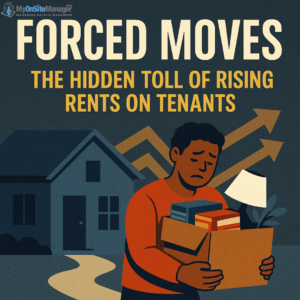Evictions in America aren’t just happening in courtrooms. Across the country, tenants are being pushed out of their homes without ever stepping foot in front of a judge. The reason? Skyrocketing rents, neglected repairs, and a lack of tenant protections have created a wave of informal evictions—a crisis hiding in plain sight.
The NAACP Legal Defense Fund’s new report, Forced Moves, reveals how these under-the-radar displacements are reshaping neighborhoods and deepening racial inequalities in housing.
The Scale of Informal Evictions
According to recent data, over 14 million tenants in the United States report feeling compelled to leave their homes due to rent increases. But that number might not even scratch the surface.
Informal evictions may occur up to five times more frequently than formal evictions.
Unlike formal evictions—which are tracked through court records and legal filings—informal evictions happen off the books. They often leave no paper trail, yet they result in just as much disruption, displacement, and trauma for families.
A Disproportionate Impact on Black Renters
The housing crisis doesn’t affect everyone equally. Black renters, especially Black women, are bearing the brunt of this wave of informal evictions:
-
Black households are more likely to be severely rent-burdened, meaning they spend over half their income just to keep a roof over their heads.
-
Black women renters are the most likely to experience forced moves due to both systemic inequality and the legacy of discriminatory housing practices.
As the report points out, this isn’t just an economic issue—it’s a civil rights issue. The growing number of informal evictions is deepening racial disparities in housing access and economic stability.
What Is an Informal Eviction?
An informal eviction is when a tenant is pushed out without the formal legal process. This can happen through:
-
Sudden, unmanageable rent increases
-
Landlords refusing to fix basic repairs
-
Verbal pressure or intimidation to leave
-
Tenants feeling they have “no choice” but to vacate
Sometimes the pressure is subtle. Other times, it’s aggressive. In either case, it results in families losing their homes, often with no recourse and no ability to contest it.
Common Causes of Informal Evictions
The Forced Moves report outlines several key drivers behind these evictions:
-
Unaffordable Rent Hikes
As rental prices climb, many tenants are left behind. If a tenant can’t afford a 20% or even 50% jump in rent, they often leave voluntarily—technically not evicted, but forcibly displaced. -
Withheld Repairs and Maintenance
More than 8 million tenants reported that their landlords refused to make essential repairs. Living without heat, water, or working plumbing forces tenants out without the need for an eviction notice. -
Lack of Legal Protections
In many states, landlords are not required to offer lease renewals or justify rent increases, allowing them to remove tenants without going through legal channels. -
Systemic Inequities
Decades of redlining, exclusionary zoning, and limited access to legal representation all fuel this problem—especially for communities of color.
The Hidden Consequences
Forced moves are traumatizing and destabilizing. The impact ripples out beyond just the individual tenant:
-
Families are uprooted from schools, jobs, and communities.
-
Children face increased risks of academic disruption and emotional stress.
-
Health outcomes worsen, particularly for seniors and those with chronic conditions.
-
Homelessness risks rise, especially when emergency shelter systems are already overburdened.
Informal evictions contribute to a cycle of poverty and instability that’s hard to escape.
Policy Recommendations: What Can Be Done?
To address this growing crisis, the NAACP LDF recommends a multi-pronged strategy that includes:
-
Stronger Rent Regulations
-
Limit how much rents can increase year-to-year to protect tenants from price gouging.
-
-
Good Cause Eviction Protections
-
Require landlords to provide a justifiable reason before asking a tenant to leave.
-
-
Right to Counsel in Eviction Cases
-
Ensure tenants have legal representation, just like landlords do.
-
-
Enhanced Housing Quality Standards
-
Enforce repair and maintenance requirements to prevent “repair-based” evictions.
-
-
Data Collection on Informal Evictions
-
Develop systems to track and study informal evictions so the full scope is no longer invisible.
-
Final Thoughts
As rents rise across the country, the true housing crisis isn’t just about who’s being taken to court—it’s also about who’s being quietly pushed out. Informal evictions are a silent epidemic, affecting millions, yet flying under the radar of public policy and public awareness.
This crisis demands more than just legal reform—it requires a shift in how we view housing rights in America. Safe, stable housing is not a luxury. It is a basic human need.
Source: Forced Moves: How Rent Increased are Driving Informal Evictions Across the Country – NAACP LDF

